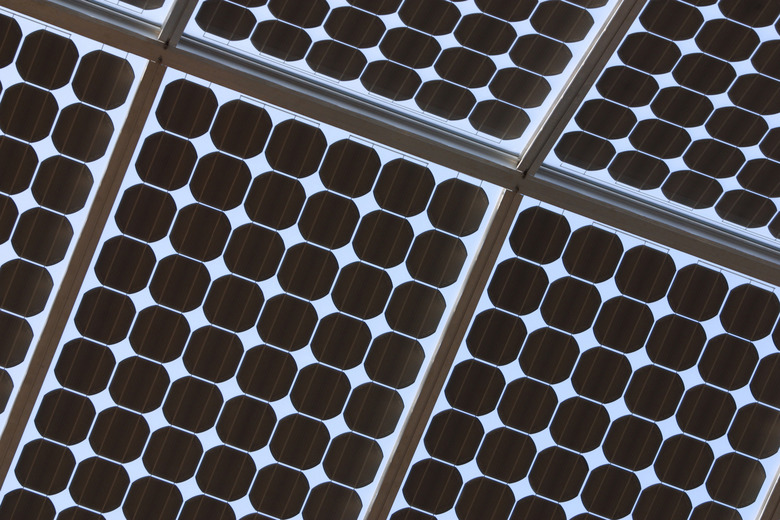The Future Of Photovoltaic Cells
The first photovoltaic cells, developed in the 1950s to power communications satellites, were very inefficient. Since those days, solar-cell efficiencies have climbed steadily while costs have dropped, although there remains plenty of room for improvement. In addition to lower cost and better efficiency, future advances in photovoltaic materials will likely lead to wider use of solar power for novel, environmentally friendly applications.
Lower Cost
Photovoltaic cells were key to the first communications satellites because few alternatives could produce reliable electricity for long periods, especially with no maintenance. The high cost of a satellite justified using expensive solar cells for power. Since then, costs for solar cells have dropped significantly, leading to inexpensive mobile devices such as solar-powered calculators and cellphone chargers. For large-scale power generation, the cost for every watt of electricity produced from photovoltaics remains higher than alternatives such as energy from coal or nuclear power. The overall trend for decreasing costs for solar cells is likely to continue into the foreseeable future.
Higher Efficiency
An efficient solar cell produces more electricity from a given amount of light compared to an inefficient one. Efficiency depends on several factors, including the materials used in the photovoltaic cell itself, the glass used to cover the cell and the cell's electrical wiring. Improvements, such as materials that convert a larger part of the Sun's light spectrum into electricity have radically increased solar-cell efficiency. Future advances will likely increase efficiencies further, wringing more electrical energy from light.
Flexible Formats
A traditional photovoltaic cell is a flat piece of silicon material, covered in glass and bonded to a metal panel; it is effective but not very flexible. Current research in photovoltaic materials has led to cells that are painted onto a variety of surfaces, including paper and plastic sheets. Another technique places an ultra-thin film of material onto glass, resulting in a window that lets light in and produces electricity. Greater variety in photovoltaic materials in the future may lead to solar-powered house paint, road paving, a coat that recharges your cell phone, and other advanced applications.
Nanotechnology
Advances in nanotechnology, the study of material properties at the atomic and molecular levels, have great potential for improving photovoltaic cells. For example, the size of microscopic particles in photovoltaic materials affects their ability to absorb specific colors of light; by fine-tuning the size and shape of molecules, scientists can increase their efficiency. Nanotechnology may also one day lead to a desktop 3D-printer that produces atomically-precise solar cells and other devices at very low cost.
Solar Car?
Although photovoltaic cells hold great promise in future applications, they will also contend with some hard physical limits. For example, it's unlikely that a completely sun-powered passenger car will have the performance or utility of a typical current gas-powered model. Although sun-powered vehicles have run in competitions, these are for the most part highly specialized million-dollar prototypes that require sunny desert conditions. The limiting factor is the sunlight the Earth receives, which amounts to 1,000 watts per meter under ideal conditions. The smallest practical electric motor for a car requires about 40kW of energy; at 40 percent efficiency, this means a solar panel 100 square meters or 1,000 square feet in area. On the other hand, a practical solar panel might someday power a small runabout vehicle for occasional use or extend the driving range for a plug-in hybrid. The limited energy in sunlight restricts the performance of any vehicle that relies on photovoltaic cells.
References
- Solar Energy Industries Association: Cost of Solar Energy Continues Significant Decline
- George Washington University: How Much Solar Energy is Available?
- Forbes: The Direct Costs of Energy: Why Solar Will Continue To Lag Hydro And Nukes
- Unbounding the Future: The Nanotechnology Revolution; K. Eric Drexler, Chris Peterson, Gayle Pergamit
- Forbes: Nanotechnology's Revolutionary Next Phase
- University of California, San Diego: A Solar-Powered Car?
Cite This Article
MLA
Papiewski, John. "The Future Of Photovoltaic Cells" sciencing.com, https://www.sciencing.com/future-photovoltaic-cells-7864/. 24 April 2017.
APA
Papiewski, John. (2017, April 24). The Future Of Photovoltaic Cells. sciencing.com. Retrieved from https://www.sciencing.com/future-photovoltaic-cells-7864/
Chicago
Papiewski, John. The Future Of Photovoltaic Cells last modified March 24, 2022. https://www.sciencing.com/future-photovoltaic-cells-7864/
